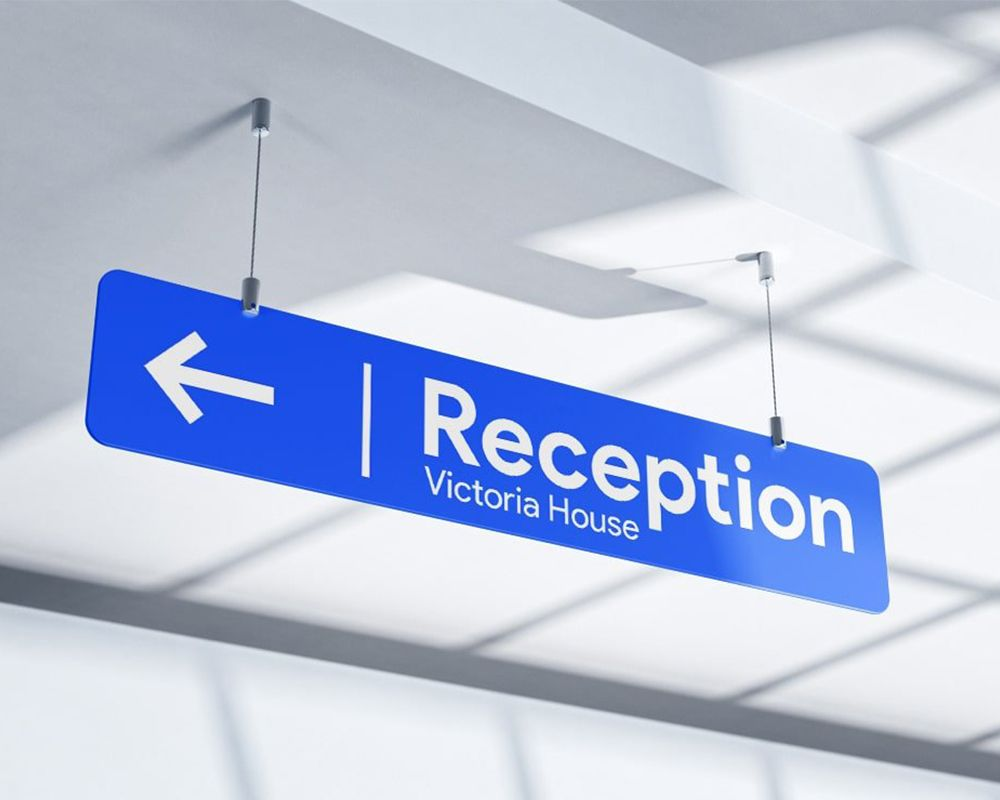The Power of Directional Signage: Guiding the Way with Purpose

Let’s see how directional signage is helping us reach our exact destination without any hassle. The importance of signage is more than just arrows and text on a board helping pedestrians to be in the right spot. We see whether, in bustling corporate offices, hospitals, or crowded public venues, these are valuable. They’re the unsung heroes of navigation, ensuring people move with purpose and ease.
- Clarity in Chaos:
Directional signs make it easy and guide people to their destinations. With the right sign making it easy and good.
- Brand Reinforcement:
Well custom designed signage reflects a company’s identity leaving with a better impact.
- Safety and Accessibility:
Prominent clear signs ensure safe navigation made inclusively for those with disabilities or face difficulties.

The True Value of Directional Signage
Directional signage is equally important, like other signs , its role has been valued just because of its usage. A sign can only take you where you want to go and pointing to the nearest location be it washroom or exit. In high-traffic areas like airports, malls, or corporate campuses, effective signage reduces stress and saves time. Imagine arriving at a hospital during an emergency clear, concise directional signs can be a lifeline, guiding you to the right department without delay.Beyond functionality, these signs contribute to operational efficiency. In corporate settings, they streamline movement, ensuring employees and visitors reach meeting rooms, offices, or amenities without disruption. This minimizes wasted time and boosts productivity. For public spaces, well-placed signage can reduce the need for staff assistance, allowing resources to be allocated elsewhere. The real meaning of directional signage lies in its ability to create order, foster independence, and elevate the overall experience of a space.
Moreover, directional signage plays a pivotal role in safety. In emergencies, such as fires or evacuations, exit signs and directional arrows can save lives by guiding people to safety quickly. Accessibility is another key aspect—signs with braille, high-contrast colors, or multilingual text ensure inclusivity, catering to diverse audiences, including those with visual impairments or language barriers.
Types of Directional Signage
Directional signage comes in many different forms, each created for specific applications and environments. Understanding them helps organizations choose the right solutions for their buildings.
Wall-Mounted Signs:
These permanent signs, most commonly installed at eye level, offer directions to main spaces like offices, restrooms, or exits. They’re common in office complexes and public facilities due to their visibility and permanence.
Freestanding Signs:
Also known as pylon or directory signs, they are typically installed in lobbies or open areas. They provide a summary of a building configuration, with directories of departments, floors, or principal destinations. These best suit large complexes such as universities or shopping complexes.

Ceiling-Mounted Signs:
Suitable for high-traffic locations like convention centers or airports, suspended overhead signs can be seen from a distance. They prefer to guide people through extensive, open areas where there are many routes.
Floor Signage:
Used in factories, hospitals, or warehouses, floor directional signs guide foot traffic or equipment travel. These are tough and effective in cases where wall or ceiling signs will not suffice.
Digital Signage:
A modern solution, digital signage offers dynamic directional signage with real-time updates. They’re ideal for spaces like event venues or transit hubs, where directions frequently change.
Temporary Signage:
For temporary situations or workspaces that are being renovated, these versatile signs provide temporary directional signage. They’re easily movable to adapt to changing requirements.
Each plays a particular role, and the most powerful systems are often a combination of several to create one cohesive wayfinding strategy.
Why Corporates and Other Industries Need Directional Signage
To businesses, directional signs are an asset. A well-designed system signifies professionalism and attention to detail, bolstering brand image. Company logo, color, or font-designed custom signs offer a cohesive appearance that is appropriate for the organization’s image. The existing branding impresses clients, partners, and employees positively, signifying a well-organized and thoughtful environment. Within the office of a company, signage supports the workflow. Employees traversing large campuses or high-rise buildings appreciate clear signage directing them to meeting rooms, cafeterias, or spaces for collaboration. This reduces frustration and optimizes productivity, as employees spend fewer moments searching for something and more moments working. For guests, reasonable signage offers a good experience with fewer opportunities to feel lost or disoriented.
Other sectors, such as retail, healthcare, and education, share such benefits. In hospitals, directional signs are crucial to guide patients and families to departments of radiology or emergency rooms. Clear direction reduces worry and enables quicker access to treatment. In supermarkets, signs guide customers to a specific aisle, making shopping simpler and potentially increasing sales. Universities use signs to guide students and visitors through large campuses, to lecture halls or administrative offices, without any trouble.
Directional signage also facilitates regulatory compliance. Compliance with accessibility standards, such as the Americans with Disabilities Act (ADA), which mandates braille or tactile signs for individuals with vision impairments, is required in most industries. Properly planned signage allows organizations to meet these standards, avoiding legal issues and embracing inclusivity.

The Broader Impact
Investing in directional signage is an investment in safety, efficiency, and customer experience. A well-designed system anticipates user needs, guiding them smoothly while defining a space’s identity and intent. Poor signage, on the other hand, inspires confusion, frustration, and even danger. Imagine a convention center with incomplete or ambiguous signs, guests miss events, and organizers lose reputation.
Directional signage design matters too. Clear, concise, and visually appealing signs use legible fonts, high contrast colors, and simple symbols. Location matters too, signs go where users intuitively look, for instance, at points of decision like intersections or entrances. Design and messaging consistency across a place makes the experience seamless, navigating second nature.
In the world of today, with its fast pace and time being of the essence and first impressions mattering, directional signage is not a desire but a necessity. It takes the place between caution and clarity and guides individuals with purpose. To business and other sectors, it is an enabler of efficiency, a brand creator, and a user well-being prioritizer. By investing in smart, well-designed signage, organizations create spaces in which everyone can travel efficiently and seamlessly, destination irrelevant. So contact ARC India for all your safety signages.

